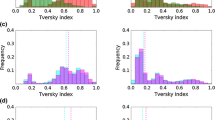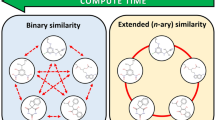Abstract
The assessment of small molecule similarity is a central task in chemoinformatics and medicinal chemistry. A variety of molecular representations and metrics are applied to computationally evaluate and quantify molecular similarity. A critically important aspect of molecular similarity analysis in chemoinformatics and pharmaceutical research is that one is typically not interested in quantifying the degree of structural or chemical similarity between compounds per se, but rather in extrapolating from molecular similarity to property similarity. In other words, one assumes that there is a correlation between calculated similarity and specific properties of small molecules including, first and foremost, biological activities. Although similarity is a priori a subjective concept, and difficult to quantify, it must computationally be assessed in a formally consistent manner. Otherwise, there is little utility of similarity calculations. Consistent treatment requires approximations to be made and the consideration of alternative computational similarity concepts, as discussed herein.
Access this chapter
Tax calculation will be finalised at checkout
Purchases are for personal use only
Similar content being viewed by others
References
Bender A, Glen RC (2004) Molecular similarity: a key technique in molecular informatics. Org Biomol Chem 2:3204–3218
Auer J, Bajorath J (2008) Molecular similarity concepts and search calculations. Methods Mol Biol 453:327–347
Maggiora G, Vogt M, Stumpfe D, Bajorath J (2014) Molecular similarity in medicinal chemistry. J Med Chem 57:3186–3204
Kubinyi H (1998) Similarity and dissimilarity: a medicinal chemist’s view. Perspect Drug Discov Des 9–11:225–232
Lajiness MS, Maggiora GM, Shanmugasundaram V (2004) Assessment of the consistency of medicinal chemists in reviewing sets of compounds. J Med Chem 47:4891–4896
Barnard JM (1993) Substructure searching methods. Old and new. J Chem Inf Comput Sci 33:532–538
Willett P (1999) Dissimilarity-based algorithms for selecting structurally diverse sets of compounds. J Comput Biol 6:447–457
Martin YC (2001) Diverse viewpoints on computational aspects of molecular diversity. J Comb Chem 3:231–250
Bajorath J (2001) Selected concepts and investigations in compound classification, molecular descriptor analysis, and virtual screening. J Chem Inf Comput Sci 41:233–245
Stahura FL, Bajorath J (2003) Partitioning methods for the identification of active molecules. Curr Med Chem 10:707–715
MACCS Structural Keys; Accelrys: San Diego, CA
James CA, Weininger D. Daylight theory manual. Daylight Chemical Information Systems, Inc., Irvine, CA
Rogers D, Hahn M (2010) Extended-connectivity fingerprints. J Chem Inf Model 50:742–754
Good AC, Richards WG (1998) Explicit calculation of 3D molecular similarity. Perspect Drug Discov Des 9–11:321–338
Rush TS, Grant JA, Mosyak L, Nicholls A (2005) A shape-based 3D scaffold hopping method and its application to a bacterial protein–protein interaction. J Med Chem 48:1489–1495
Bradley EK, Beroza P, Penzotti JE, Grootenhuis PDJ, Spellmeyer DC, Miller JL (2000) A rapid computational method for lead evolution: description and application to alpha(1)-adrenergic antagonists. J Med Chem 43:2770–2774
Gund P (1977) Three-dimensional pharmacophore pattern searching. In: Hahn FE (ed) Progress in molecular and subcellular biology, vol 5. Springer, Berlin, pp 117–142
Johnson MA, Maggiora GM (eds) (1990) Concepts and applications of molecular similarity. Wiley, New York
Stumpfe D, Bajorath J (2011) Similarity searching. Wiley Interdiscip Rev Comput Mol Sci 1:260–282
Willett P, Barnard JM, Downs GM (1998) Chemical similarity searching. J Chem Inf Comput Sci 38:983–996
Maggiora GM, Shanmugasundaram V (2004) Molecular similarity measures. Methods Mol Biol 275:1–50
Tanimoto TT (1957) IBM internal report. Nov 17
Tversky A (1977) Features of similarity. Psychol Rev 84:327–352
Fligner M, Verducci J, Blower PA (2002) Modification of the Jaccard-Tanimoto similarity index for diverse selection of chemical compounds using binary strings. Technometrics 44:110–119
Nisius B, Bajorath J (2010) Rendering conventional molecular fingerprints for virtual screening independent of molecular complexity and size effects. ChemMedChem 5:859–868
Schuffenhauer A, Floersheim P, Acklin P, Jacoby E (2003) Similarity metrics for ligands reflecting the similarity of the target proteins. J Chem Inf Comput Sci 43:391–405
Vogt M, Stumpfe D, Geppert H, Bajorath J (2010) Scaffold hopping using two-dimensional fingerprints: true potential, black magic, or a hopeless endeavor? Guidelines for virtual screening. J Med Chem 53:5707–5715
Heikamp K, Bajorath J (2011) Large-scale similarity search profiling of CHEMBL compound data sets. J Chem Inf Model 51:1831–1839
Author information
Authors and Affiliations
Corresponding author
Editor information
Editors and Affiliations
Rights and permissions
Copyright information
© 2017 Springer Science+Business Media New York
About this protocol
Cite this protocol
Bajorath, J. (2017). Molecular Similarity Concepts for Informatics Applications. In: Keith, J. (eds) Bioinformatics. Methods in Molecular Biology, vol 1526. Humana Press, New York, NY. https://doi.org/10.1007/978-1-4939-6613-4_13
Download citation
DOI: https://doi.org/10.1007/978-1-4939-6613-4_13
Published:
Publisher Name: Humana Press, New York, NY
Print ISBN: 978-1-4939-6611-0
Online ISBN: 978-1-4939-6613-4
eBook Packages: Springer Protocols




